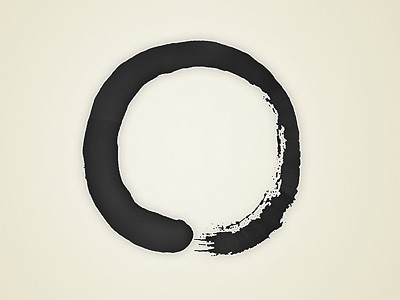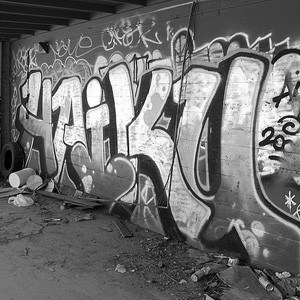Being emptiness
By S. D.

When I first read the great Heart Sutra, I found myself both intrigued and frightened by its implication. To think that I am nothing more than a series of aggregates, that everything I have done in the past, or present for that matter, comes down to conditioned responses based upon a false idea of “self” sent shivers down my spine.
Yet, like I said, it is also intriguing. One could get lost in thinking about the potentiality for change that emptiness allows in our lives. More often than not, the Western mind views emptiness as something bereft of worth or substance and therefore, necessarily avoided. Eastern thought, on the other hand, views it as both a positive and negative, both worthy of embrace.
Emptiness is indeed a negative in the sense that it destroys one’s concept of reality based upon the individual. It does away with assumptions we carry around about ourselves and the world around us. But, therein lies the positive as well. It makes open to us a reality far more spectacular than we imagine in our narrow views, an infinity within every moment.
Emptiness leaves it all up to us. It allows us to stop avoiding, stop grasping, stop trying to live the imaginary ideas we think ourselves to be, but in the end, only bring about pride, egoism, anger, jealousy and all the other troubles we find ourselves embroiled in throughout our daily lives. It allows us to experience the world and the people around us without our having to raise our defenses through the discriminatory process.
Think about it. What do we fear? What is it we are constantly trying to protect? We fear the annihilation of self. We try to protect it from any supposed dangers that threaten extinction. But, if we are the aggregates of form, feeling, thought, impulse and consciousness, we are annihilated with every moment’s passing. In its place is formed a new being composed in turn from the latest aggregate blend.
Unfortunately, with every new blend of the aggregates, we desperately try to drag the baggage of the one just past along with us. We insist on believing that that old baggage is with us.
Phenomenal reality flows through the six gates of eye, ear, nose, tongue, body and mind. We hear the melody of a songbird outside our window and we smile, overcome with a momentary feel of quiet and rest. Anxiety slips away as we recall some past moment. Perhaps it’s a picnic in the park, or maybe the memory of a mother’s lullaby to her dozing child.
Then, from further down the tier comes a toilet’s flush. No longer the life-affirming memory, but the sudden reminder and affirmation of bleak surroundings. No longer do we feel the impulse to smile, but to frown, to clench the fist in anger and frustration.
So, what changed from the one moment to the next moment? All things are empty. The songbird’s melody is no more or better a vibratory stimulus upon the ear than the flush. The electrical signals firing within the contours of the brain are made of the same stuff either way. They have no intent to make us angry or sad or happy. So, why the change? Why do we feel one was good and the other bad?
In the end it had nothing whatsoever to do with the incoming phenomenon itself, but with all that baggage. That baggage conditions our hearts and minds to react in impulsive, sometimes compulsive ways that bring us affirmation and negate all else that might hint at the fact that we are not all of what we imagine ourselves to be.
I don’t know. Perhaps it all starts out innocently enough. To “be” in the conventional sense of the world means that we must survive. We have to learn what is pleasant or unpleasant as part of that survival. A baby cries when it is hungry. Form, feeling, thought, impulse and consciousness are all there—and, rightly so. If it weren’t, the baby might never get fed. The process seems so natural.
Yet, somewhere along the line we begin to twist what is natural and healthy into something else, imbuing human qualities to the inanimate, attaching memories to the moment for no other purpose than the continuation of delusion we call self. We end up believing that the things around us are what make us happy or sad or angry.
I wonder if the process itself isn’t a clear indication that self is ultimately nonexistent. Why else would we need to project so much onto the external, unless there was no true self to hold onto internally? Certainly Zen Masters of the past understood this, hence the emphasis on sitting meditation. What better way to discover the delusion than to have to sit there and confront it face to face until emptiness itself is realized.
I think that when we begin to get a sense of emptiness for what it is, we find ourselves empowered with a greater sense of responsibility as well. We find ourselves being forced to leave the blame for our thoughts, feelings and actions on our own doorstep instead of blaming everything and everyone else in the world around us. It isn’t the toilet’s fault my brow furrows. It is me. If I don’t like it, I have to be the one to change the conditioning. When we surrender the image we have guarded so zealously, when we surrender the false sense of control we feel we need over the world, the world changes in leaps and bounds.
Zen Master Dogen tells us in the Fukanzazengi (The Universal Promotion of the Principals of Zazen), “The Way is basically perfect and all pervading.” However, he goes on to warn us that if the least like or dislike arises, the mind becomes lost in confusion. Why? Because our likes and dislikes are the very stuff of delusion, centered on a self that doesn’t exist except in the created layers of our own mind.
These layers serve no other purpose than to separate us from the unity shared by all beings everywhere. It keeps us isolated in our own little worlds, loving only ourselves and that which makes us happy.
Compassion for fellow beings is an impossibility if we see ourselves as somehow different. First and foremost in the vows of every Buddhist is that, however innumerable all beings are, we vow to save them all. The implication is that salvation can never be reached by the individual alone. It is a group effort that requires each of us to empty ourselves, to go beyond the imaginations and concerns for self, and embrace the unity found in the emptiness spoken of in the Heart Sutra.
It may be comforting to think of ourselves as possessing some enduring character with a past, present and future. It may give us confidence to believe we are firmly grounded in the reality and understanding of the conventional world around us. But, what energy it takes! Every moment is spent in a futile attempt to validate the impossible, always preventing us from seeing what is really there.
To surrender, to drop the baggage and allow ourselves to be empty, ultimately negates the suffering engendered by our created image of self. Once empty, the world is allowed room to flow, to be experienced in all the wonder it truly is. “Perfect and all pervading,” Master Dogen tells us. Perhaps it’s time to take him at his word and get on with it.
Incarcerated people
Many incarcerated people from all over the United States correspond with Venerable Thubten Chodron and monastics from Sravasti Abbey. They offer great insights into how they are applying the Dharma and striving to be of benefit to themselves and others in even the most difficult of situations.


